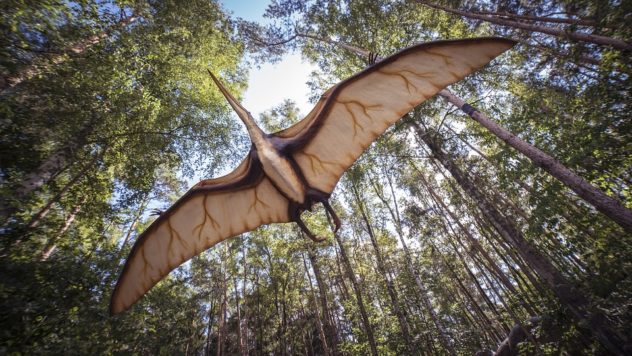Vocabulary:
- capability /key-puh-BIL-i-tee/
- renowned /ri-NOUND/
- uneven /uhn-EE-vuhn/
- specimen /SPES-uh-muhn/
- diversity /dih-VUR-si-tee/
[noun] the ability to do something
Some birds have the capability to make their own nest out of their saliva.
[adjective] the state of being famous
The oak forests, for which it was renowned in Roman times, have entirely disappeared.
[adjective] not equal
The stone beneath her feet was uneven, worn out, and old.
[noun] something shown or examined as an example; a typical example
Its vaulted roof is a fine specimen of Saracenic brickwork.
[noun] the condition or fact of being different or varied
The zoo contains a large diversity of animals.
A new species of Pterosaurs that lived during the age of the dinosaurs 95 million years ago has been discovered by the researchers. The well-preserved remains of the said creature were uncovered in a limestone quarry in Lebanon more than 15 years ago. Pterosaurs were a classification of flying reptiles during the dinosaur age, and the first group of animals to develop the capability of flight. Pterosaur remains are renowned from every modern-day continent; however, the record of its fossil is uneven because of the few deposits that justify the vast majority of specimens. These flying reptiles are best defined as shedding new and much-needed information on the evolutionary history of the creatures.
The newly found specimen is the most complete pterosaur that has been discovered. The pterosaur was the first group of vertebrates to achieve powered flight which is quite rare in the African continent, according to Alexander Kellner, an author of the research from the Museu Nacional. According to Michael Caldwell, a co-author of the study, the diversity of these ancient animals is more varied than they were ever able to discover from the fossil record. Caldwell also mentioned, “This means that this Lebanese pterodactyloid was part of a radiation of flying reptiles living in and around and across the ancient Tethys Seaway, from China to a great reef system in what is today Lebanon.”
The newly found specimen is the most complete pterosaur that has been discovered. The pterosaur was the first group of vertebrates to achieve powered flight which is quite rare in the African continent, according to Alexander Kellner, an author of the research from the Museu Nacional. According to Michael Caldwell, a co-author of the study, the diversity of these ancient animals is more varied than they were ever able to discover from the fossil record. Caldwell also mentioned, “This means that this Lebanese pterodactyloid was part of a radiation of flying reptiles living in and around and across the ancient Tethys Seaway, from China to a great reef system in what is today Lebanon.”
True or False:
- A new species of Pterosaurs that lived after the age of the dinosaurs 95 million years ago was found by researchers.
- The record of its fossil matches the majority of specimens.
- The newly found specimen is not the most complete pterosaur that has been discovered.
- The pterosaur was the first group of invertebrates to achieve powered flight.
- The Lebanese pterodactyloid was part of a group of flying dinosaurs living in and around and across the ancient Tethys Seaway.
Discussion Questions:
- What can you say about the discovery of another species of pterosaur?
- What do you find interesting in uncovering new species of animals?
- Are you fond of dinosaurs? Why or why not?
- What creature reminds you of dinosaurs? Kindly elaborate why.
- What is the difference between vertebrates and invertebrates?
Express Your Opinion:
- “The extinctions ongoing worldwide promise to be at least as great as the mass extinction that occurred at the end of the age of dinosaurs.
- “Our journey’s not over. We can only hope that in some small way our time here will be remembered”. – Dino Time movie
- “We all have a dinosaur deep within us just trying to get out”. – Colin Mochrie
